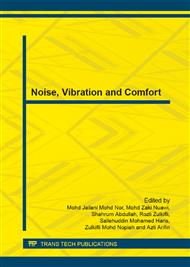p.40
p.45
p.52
p.59
p.64
p.69
p.74
p.81
p.89
Car Cabin Interior Noise Classification Using Temporal Composite Features and Probabilistic Neural Network Model
Abstract:
Determination of vehicle comfort is important because continuous exposure to the noise and vibration leads to health problems for the driver and passengers. In this paper, a vehicle comfort level classification system has been proposed to detect the comfort level in cars using artificial neural network. A database consisting of sound samples obtained from 30 local cars is used. In the stationary condition, the sound pressure level is measured at 1300 RPM, 2000 RPM and 3000 RPM. In the moving condition, the sound is recorded while the car is moving at 30 km/h up to 110 km/h. Subjective test is conducted to find the Jurys evaluation for the specific sound sample. The correlation between the subjective and the objective evaluation is also tested. The relationship between the subjective results and the sound metrics is modelled using Probabilistic Neural Network. It is found from the research that the Temporal Composite Feature gives better classification accuracy for both stationary and moving condition model, 89.51% and 85.61% respectively.
Info:
Periodical:
Pages:
64-68
Citation:
Online since:
December 2013
Authors:
Price:
Сopyright:
© 2014 Trans Tech Publications Ltd. All Rights Reserved
Share:
Citation:


